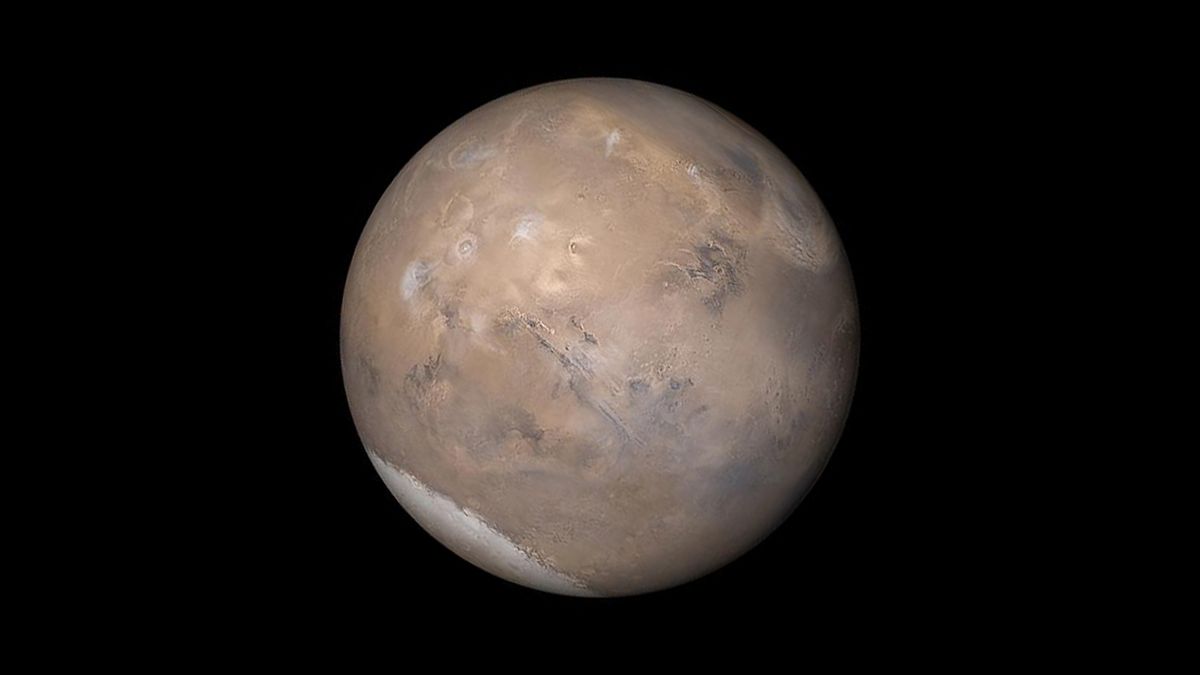
Scientists have uncovered further evidence that liquid water exists beneath the ice cap at the southern pole of Mars and it may mean that the planet is geothermally active.
In 2018, the European Mars Express orbiter found that the surface of the ice cap covering the south pole of Mars dips and rises, suggesting liquid water may be lurking underneath. But not all scientists were convinced at that time. Mars is extremely cold, and for subglacial water to exist on the planet in the liquid form, there would have to be a source of heat, such as geothermal energy. At the time of the Mars Express discovery, some scientists therefore thought the strange radar signal measured by the spacecraft might be explained by something else, for example some sort of dry material below the ice caps.
But recently, an international team of scientists led by researchers from the University of Cambridge investigated the ice-sheet-covered region, known as Ultimis Scopili, using a different technique and concluded that the presence of liquid water is, indeed, the likeliest explanation.
Related: Water may have been on Mars much more recently than scientists thought, China’s rover suggests
Using spacecraft laser-altimeter measurements from NASA’s Mars Global Surveyor satellite to map the topography, or shape, of the upper surface of the ice cap, the researchers detected subtle patterns of height differences that matched computer model predictions for how a body of water beneath the ice cap would affect its surface.
“The combination of the new topographic evidence, our computer model results, and the radar data make it much more likely that at least one area of subglacial liquid water exists on Mars today,” Neil Arnold, a professor of geography at Cambridge University, said in a statement (opens in new tab).
Scientists have been aware that Mars has thick water ice caps at both poles just like Earth. But they believed that, unlike the ice caps of our planet which have water-filled channels and subglacial lakes below them, the Red Planet’s ice caps were frozen all the way down to their base or bed because of the planet’s cold climate. The shape of the Martian ice caps was selected as an independent line of evidence to confirm the radar results because on Earth, scientists have observed that the shape of an overlying ice sheet is influenced by the body of water beneath it.
This is because the water in subglacial lakes lowers the friction between an ice sheet and its bed, allowing the ice to flow faster under the influence of gravity. On the surface of the ice sheet, this change in speed is reflected by a dip in its surface followed by a rise in the ice surface further down the ice flow.
Examining the surface topography from the same area where Mars Express made its radar measurements, the team found a 6.2 mile to 9.3-mile-long (10 to 15 kilometers) surface undulation.
This feature consisted of a depression in the ice surface followed by a corresponding raised area, both deviating from the level of the surrounding ice cap area by several meters. This scale and shape resemble that of undulations in ice sheets above subglacial lakes found on Earth, the researchers said in the statement
To test this correlation and to determine if the surface undulation of the Martian ice cap could be the result of subglacial water, the team ran simulations of ice flow adapted to specific conditions on Mars.
They introduced into their computer model of a Martian ice sheet a patch of reduced bed friction where water would allow the ice flow to speed up. The researchers also adjusted the amount of geothermal heat in the simulation.
These simulations resulted in undulations in the computer-modeled ice surface that were similar in both size and shape to the observed features of the actual southern polar ice cap on Mars.
A combination of the results from this simulation, the new topography observations of the ice cap, and the 2018 radar results point toward the existence of subglacial water beneath the southern polar ice cap, with deeper implications for the geology of the Red Planet.
Related stories:
The team thinks their results indicate that the geothermal heat needed to account for the subglacial water may come from magmatic activity that has occurred relatively recently in the subsurface of Mars.
“Mars must still be geothermally active in order to keep the water beneath the ice cap liquid,” Arnold added. “The quality of data coming back from Mars, from orbital satellites as well as from the landers, is such that we can use it to answer really difficult questions about conditions on, and even under the planet’s surface.
“It’s exciting to use these techniques to find out things about planets other than our own.”
The team’s research is published in the journal Nature Astronomy (opens in new tab).
Follow us on Twitter @Spacedotcom and on Facebook.



